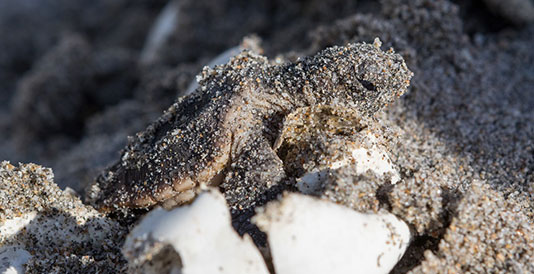 January 22, 2018 (Source: FAU) - Alarming results from a recent gender ratio study revealed that 99 percent of young green turtles from Australia’s Northern Great Barrier Reef are female and that male sea turtles are disappearing. Closer to home, researchers from Florida Atlantic University have documented a similar trend in sea turtle hatchlings in southeast Florida. Since 2002, they have studied sea turtles in Palm Beach County and discovered that 97 to 100 percent of the hatchlings have been female. In a study published in Zoology , FAU researchers are the first to show why and how moisture conditions inside the nest affect the development and sex ratios of turtle embryos. They are the first to estimate sex ratios using a male-specific, transcriptional molecular marker Sox9, a marker of testis development in sea turtles and freshwater turtles. The researchers found that the coolest and the wettest substrates produce 100 percent males compared to 42 percent males from the warmest and driest treatment. They also found that embryonic growth appears to be more sensitive to temperature at earlier stages of development and to moisture at later stages. “During incubation, the turtle embryo grows inside the nest from a few cells to a fully formed and independent organism at hatching,” said Jeanette Wyneken, Ph.D., author of the study and a professor of biological sciences in FAU’s Charles E. Schmidt College of Science. “For proper development, embryos require an appropriate range of temperature, moisture, salinity, and respiratory gases.”
January 22, 2018 (Source: FAU) - Alarming results from a recent gender ratio study revealed that 99 percent of young green turtles from Australia’s Northern Great Barrier Reef are female and that male sea turtles are disappearing. Closer to home, researchers from Florida Atlantic University have documented a similar trend in sea turtle hatchlings in southeast Florida. Since 2002, they have studied sea turtles in Palm Beach County and discovered that 97 to 100 percent of the hatchlings have been female. In a study published in Zoology , FAU researchers are the first to show why and how moisture conditions inside the nest affect the development and sex ratios of turtle embryos. They are the first to estimate sex ratios using a male-specific, transcriptional molecular marker Sox9, a marker of testis development in sea turtles and freshwater turtles. The researchers found that the coolest and the wettest substrates produce 100 percent males compared to 42 percent males from the warmest and driest treatment. They also found that embryonic growth appears to be more sensitive to temperature at earlier stages of development and to moisture at later stages. “During incubation, the turtle embryo grows inside the nest from a few cells to a fully formed and independent organism at hatching,” said Jeanette Wyneken, Ph.D., author of the study and a professor of biological sciences in FAU’s Charles E. Schmidt College of Science. “For proper development, embryos require an appropriate range of temperature, moisture, salinity, and respiratory gases.”
(Photo credit: Jay Paredes)













